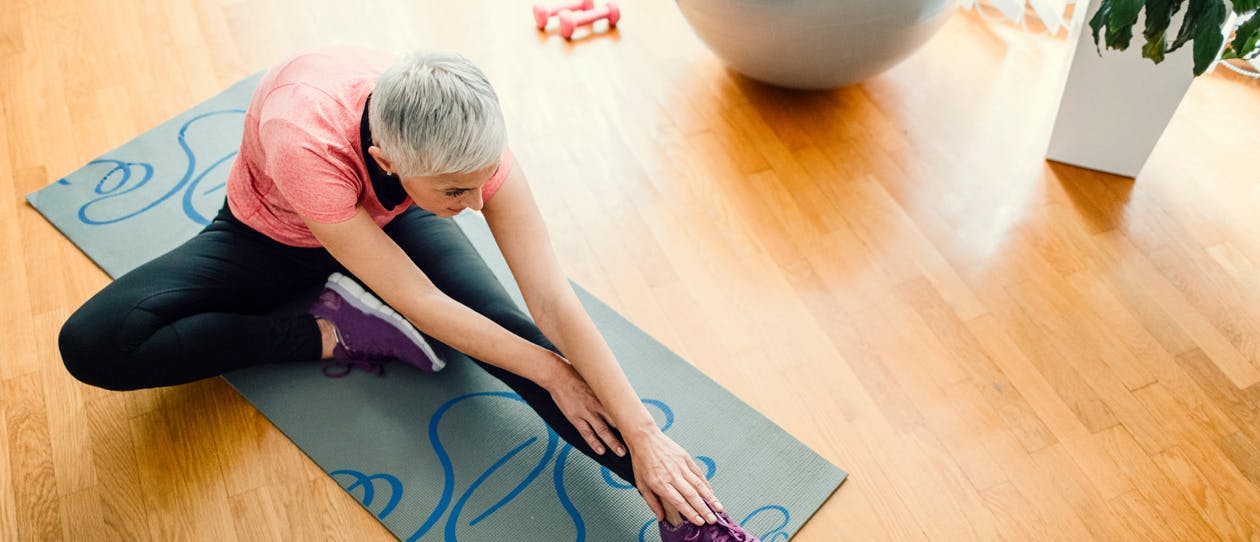1. Always warm up
A warm up raises your body temperature and increases blood flow to the working muscles and joints.
It helps to promote movement and mobility, and it’s an essential part of every workout for arthritis sufferers.
Spend at least three to five minutes walking or cycling at a moderate pace so you breathe a little faster.
2. Cross train
Rotate the load on your working joints and add variety to your exercise routine by cross training.
The following routine is a great example of how to change things up with days working on the upper body and lower body.
It’s also a provides a mix of different activities and training methods. Rest and stretching days are also a focus.
- Monday – Kayaking with intervals
- Tuesday – Whole body weight training
- Wednesday – Stretch session or yoga
- Thursday – Swim or cycle - slow and steady workout
- Friday – whole body weight training
- Saturday – Walk/ jog on grass/sand
- Sunday – Rest day
3. Move in water
Be it swimming, aqua aerobics or deep water running (while wearing a floatation belt),
exercise in water is a great choice for arthritis suffers.
The buoyancy of the water supports your weight and eases pressure on the joints.
Exercise classes in heated hydrotherapy pools can be especially beneficial for those with significant joint pain.
4. Find the best time of day
While some arthritis sufferers may experience more pain in the mornings, others may experience higher levels of discomfort later in the day.
Identify the best time of day to exercise for you when arthritic pain is at its lowest.
5. Be strong
Find time for resistance training exercises at least twice a week to increase muscle strength and stablise your joints.
This could include activities such as
weight training, body weight exercises, or Pilates performed two to three times a week (with rest days in between).
Start with light weights you can lift at least 10-15 times, and increase the difficulty as you get stronger over time.
6. Sit while you workout
Just as water can help to reduce the load on your joints, so too can a seat.
Cycling and rowing / paddling are two fantastic forms of exercise for people who suffer from arthritis of the hips, knees and ankles.
You’ll still get all the cardiovascular benefits of exercise, whether you’re outdoors or sitting on exercise machine
7. Stretch regularly
Flexible muscles help to promote full range of motion around your joints, and can prevent stiffness.
Stretching exercises performed regularly as part of your exercise routine will keep your body feeling loose and agile, and will make exercise more comfortable. They can also improve performance and prevent injury.
Make sure to stretch after every workout as part of your cool down, targeting the working muscles and joints of your chosen activity.
8. Go short and often
Keeping your weight under control is especially important for people who suffer arthritis in the lower body to reduce loading on the joints.
But longer sessions of exercise necessary to mange body fat levels can be uncomfortable. It may be best to accumulate two to four shorter bouts of exercise spread over the day rather than perform one long session.
9. Try something different
Continue to experiment with different forms of low impact exercise to find what suits you best. Some suggestions include
- Nordic walking – Use poles while you walk to transfer some of the load from your lower body to the upper body
- Dancing – Gentle and rhythmic movements that elevate your heart rate while adding a social element to your exercise routine
- Tai Chi - Slow, smooth movements that improve mobility and strengthen your muscles
- Pilates – The focus on your abdominal core helps to boost stability, balance and overall muscle strength
10. Include rest days
A key component of any program of exercise is to find the
right balance between rest and activity. If you suffer from arthritis, adequate recovery time after exercise will be vital. Schedule rest days to prevent flare-ups, and include extra days if you feel sore after working out to settle inflamed joints.
And remember, if you're new to exercise see your healthcare professional before you get started.


